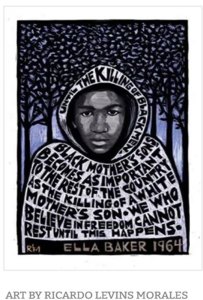Why don’t we hear very much about the real possibility of nuclear winter in the popular discourse today? That’s at least partially because those who have had a vested interest in continuing the nuclear arms race have worked to create enough controversy about nuclear winter that it has all but faded from public consciousness.
Today’s Forecast: possibility of a nuclear winter
By Mary Beaudoin, Newsletter Editor
Volume 40 Number 5 Women Against Military Madness Fall 2022
The West was rattled when President Putin alluded to the use of nuclear weapon if attacked, bur those of us in the U.S. need to look at our own role, in provoking an existential threat to Russia in its own region.
Putin’s remarks about nuclear weapons were preceded by the U.S. planting tactical, low-yield nuclear weapons (B-61 bombs) in five European countries andincreasing U.S. military deployments in Baltic states. Aegis missile-launching facilities,which can be fitted with nuclear warheads that could hit Moscow in minutes, have been installed in Poland and Romania.
Eschewing support for a negotiated peace process, the U.S./NATO continues to fuel a proxy war with Russia at the expense of the Ukrainian people. Is it any surprise then that referendums to join Russia are underway in Russian-ethnic Ukrainian provinces and the situation with the West is volatile?
Further, the current U.S./NATO war with Russia over Ukraine raises alarm about food supplies, as Russia is the world’s largest exporter of grain and Ukraine is Europe’s “breadbasket.” War, militarism,and climate change throughout other parts of the world affect food sources and contribute to famine. Nuclear winter is the ultimate scenario in which nuclear weapons and agriculture converge.
Severe Warning: “Nuclear Winter: The Other Catastrophic Climate Change,” beginning on page 4. Chance of Prevention: Advisory is to act now to ban nuclear weapons.
Wolf Winter: Vargavinter (Swedish) or Fimbul Winter (Norwegian) when the sun no longer shines is part of Scandinavian mythology. Now it’s believed that it could have had an actual basis in the year 536 when two huge volcanic explosions sent dust into the upper atmosphere, causing the earth to cool. Many plants and animals did not survive and it’s estimated that half the population of Norway and Sweden died. Similar atmospheric conditions could be produced in a regional or worldwide nuclear war. Art by Louise Meijer Ostrom
Nuclear Winter: The Other Catastrophic Climate Change
By Mark Bird
Volume 40 Number 5 Women Against Military Madness Fall 2022
Nuclear winter is the terrifying idea that nuclear bomb explosions would incinerate cities, farms, and forests, causing smoke and soot from fire to enter the upper atmosphere and block sunlight, resulting in crop failures on a large scale as temperatures drop drastically, leading ultimately to mass starvation and the possibleextinction of large numbers of species, including our own.
As plants and animals are dependent on photosynthesis, the ability to produce food for consumption by people and animals would be constrained and could cease entirely. The few remaining survivors will not eat well. “Not eating well” means no fresh fruit, vegetables, meat, fish, or milk for months or years, and could eventually mean not eating at all.
We can imagine nuclear winter occurring, from evidence provided by these localized incidents that have occurred on a smaller scale: volcanic eruptions reducing sunlight, Martian dust storms circling the planet, the 1930s dust bowl impacting several states, NASA’s report of smoke circling the globe after the 2020 Australian fires, smoke from recent U.S. West Coast fires detected on the East Coast and in Europe, and frequent annual reports of Saharan dust blocking sunlight in the southeastern U.S.
The nuclear weapons most likely to be used in a limited war are “low-yield” (tactical) weapons. Low yield means that these weapons may have as many as three times the explosive power of the 15-kiloton bombs dropped on Hiroshima in August of 1945, killing an estimated 140,000.[1] This kind of weapon was designed for use in the battlefield. Thousands of such bombs exist in stockpiles in nuclear-armed countries.
Many experts suggest that the explosion of even one low-yield nuclear weapon could rapidly lead to multiple explosions as each side retaliates against the other. If a conflict were to proceed in this fashion, as could conceivably happen in many places such as the Ukraine region, India/Pakistan, or Israel/Iran, the cities and military targets would transform into immense clouds of skyborne particles that block sunlight. If the initial attack were large enough –though with weapons far smaller than those in the arsenals of superpowers -– say with a hundred low-yield weapons – nuclear winter could be initiated.
Fantasy Winter by Stefan Keller. Summer would not come again in a nuclear winter.
Let’s imagine what happens to a single vehicle or building or forest if it is exposed to a nuclear weapon explosion. Contrary to what many people assume, the object does not disappear. Instead, it, along with many other affected objects, would transform into countless, possiblyradioactive micro-particles injected high into the atmosphere. Cumulatively they would not only block the warming effect of the sun for periods ranging from months up to years, depending on the number, yield, and range of the weapons exploded, but would eventually “fallout” onto earth. Agricultural land and water would be reduced and contaminated. A large quantity of radioactive material could land on the aggressor nation, as well as the targeted nation.
If numerous enough, the blasts alone could trigger nuclear winter. The earth’s rotation of 1,000 MPH ensures that Mother Nature’s wind and water cycle will carry smoke, dust, and ash around the planet.
Imagine then if you had a vantage point from outer space:You would see a massive dark cloud circling the tiny and fragile earth. No one would escape the effects.
Visions of nuclear winter are not often evoked now, but they were a cause of national and international concern when in 1983, Carl Sagan and some of his colleagues introduced the concept to the broader public through popular media.[2]This injected new energy into the antinuclear movement in which women activists in Europe and the U.S. had already begun playing a major role.
If a nuclear winter were triggered, smoke and soot would block the sunlight for months or years.
Why don’t we hear very much about the real possibility of nuclear winter in the popular discourse today? That’s at least partially because those who have had a vested interest in continuing the nuclear arms race have worked to create enough controversy about nuclear winter that it has all but faded from public consciousness. Undoubtedly another reason the entire topic of nuclear war faded from discussion (until the rise of recent political tensions) was the 1991 dissolution of the Soviet Union, even as thousands of nuclear weapons remained on alert in Russia and the U.S. ready to be launched at a moment’s notice and other nations continued to develop their own nuclear weapons. A 2015 public-interest report, “Nuclear War, Nuclear Winter, and Human Extinction,” published by the Federation of American Scientists, posited that “perhaps the leaders of the nuclear weapon states do not want the public to understand that their nuclear arsenals represent a self-destruct mechanism for the human race? Such an understanding could lead to a demand that nuclear weapons be banned and abolished. Consequently, the nuclear weapon states continue to maintain and modernize their nuclear arsenals, as their leaders remain silent about the ultimate threat that nuclear war poses to the human species.” [3]
However, scientists have continued to study the concept of nuclear winter and develop new research. The results can be found in specialized journals. In August 2022, Nature Food, published an article exploring various scenarios of famine due to climate disruption caused by soot resulting from the fire created by bomb blasts. Owen B. Toon, of the National Center for Atmospheric Research in Boulder, Colorado and a former student of Carl Sagan’s, was among the ten scientists from research centers in various parts of the globe who collaborated to estimate the number of human fatalities that could occur. The researchers included the devastating effect on fish and livestock, as well as on agricultural crops, in their models.[4]
Toon and some of these scientists were among another group who had created models based on a nuclear conflict between India and Pakistan, showing that “the environmental stresses related to climate changes caused by smoke produced from burning cities could lead to widespread starvation and ecosystem disruption far outside of the war zone itself”; their research paper was published October 2, 2019 in Science Advances.[5]
The concept of nuclear winter is made more accessible to the general public in a March 2020 Nature magazine article by writer Alexandra Witze, “How a Small Nuclear War Would Transform the Planet.” In it, she mentions the pushback from scientists when an attempt was made by a team from Los Alamos National Laboratory to debunk the idea of nuclear winter.[6] [This is no surprise, as Los Alamos “national security” lab is where the atomic bombs dropped on Hiroshima and Nagasaki were developed; it recently worked on modernizing the low-yield B61-12 nuclear bomb. Los Alamos is currently developing a factory to create the “pits” (basically small nuclear bombs) that would trigger larger ones in a modernized arsenal.] In August 2022, another Nature article by Witze warned about nuclear danger in “Nuclear War Between Two Nations Could Spark Global Famine.”[7]
Reaching wider audiences through mass media is not alarmist but imperative now.
Artistic visions and pop culture sometimes alert us to real concerns, as well. Apocalyptic films and video games abound everywhere today (at least one video game is about nuclear winter), but these vehicles convey the wrong messages as they show superheroes as saviors rather than people taking collective action against disarmament.[8]
A“winnable nuclear war” is one of the most inane and inhumane concepts ever voiced. The idea of nuclear winter shows it can’t be won. Hopefully, it gives the U.S. and Russia, or any of the other seven nuclear-armed nations, pause to consider what would happen to their nation, along with the entire earth, if they attacked or responded to an attack with even a limited number of nuclear bombs. There is also the possibility of a terrorist or rogue military officer’s action or a nation mistaking another nation’s action for a nuclear incident. Here is another chilling thought: Sincelow-yield nuclear weapons are in the military’s toolbox and they aren’t prohibited by any treaties, could a commander in battle make his own decision about their use?
There should be a serious effort at nuclear disarmament – for example, by exerting intense public pressure for nuclear weapons states to ratify the International Treaty on the Prohibition of Nuclear Weapons, signed by 86 other nations and ratified by 66.[9] Sadly, the U.S. is not one of them.
In a 1984 Scientific American article, “The Climatic Effects of Nuclear War,” Carl Sagan and colleagues warned: “The long-term destruction of the environment and the disruption of the global ecosystem might, in the end, prove even more devastating for the human species than the awesome destructive effects of nuclear explosions and their radioactive fallout.” It is high time for us to heed this warning.
ACTION:
In the Twin Cities, check the WAMM calendar (online at womenagainstmilitaryness.org) for local anti-nuclear events.
RESOURCES:
Back from the Brink Campaign: preventnuclearwar.org and/or call the WAMM office at 612-827-5364.
Mark Bird is a retired sociology professor who has taught at colleges in Arizona and Nevada. He wrote the book “800 Laws in Sociology.” He has written over 30 water-related articles and holds a green-seawater desalination patent. Mary Beaudoin, and Joel Weisberg, Emeritus Carleton College Professor of Physics and Astronomy, who also acted as a consultant, contributed to this report.
Endnotes
[1]Many estimates are that 66,000 died instantly. The city of Hiroshima states that “the exact number of deaths from the atomic bombing is still unknown. Estimates place the number of dead by the end of December 1945, when the acute effects of radiation poisoning had largely subsided, at roughly 140,000.”city.hiroshima.lg.jp/site/english/9803.html Many estimates give the total for instant and year’s end deaths at approximately 70,000 for Nagasaki.2]Matthew R. Francis, “When Carl Sagan Warned the World about Nuclear Winter,” Smithsonian Magazine. November tinyurl.com/46286d2r
[3]Starr, Steven. Nuclear War, Nuclear Winter, and Human Extinction. Public Interest Reports. Federation of American Scientists. October 14, 2015. tinyurl.com/yc4mcfe9
[4]Xia, L., Robock, A., Scherrer, K. et al. Global food insecurity and famine from reduced crop, marine fishery and livestock production due to climate disruption from nuclear war soot injection. Nature Food 3, 586–596 (2022). tinyurl.com/fupkxwn4
[5]Toon. Owen B. et al. Rapidly expanding nuclear arsenals in Pakistan and India portend regional and global catastrophe. Science Advances 5, no. 10 (2019). https://doi.org/10.1126/sciadv.aay5478
[6]Witze, Alexandra. How a Small Nuclear War Would Transform the Planet. Nature. Vol. 579. 485-487. March 26, 2020. tinyurl.com/3dfk5b56
[7]Witze, Alexandra. Nuclear War Between Two Nations Could Spark Global Famine. Nature. Vol. 608, p. 661. August 25, 2022. online: August 15, 2020. tinyurl.com/yeh58pry
[8]Pop culture critic Charlie Jane Anders bemoans the fact that “pop culture stopped warning us of the dangers of atomic devastation – and that’s too bad.” Anders does not address nuclear winter specifically but she has this to say: “Mass media is already awash in apocalyptic visions, but in addition to watching Thanos wipe out half of the universe with a snap of his fingers in the Avengers franchise, we need more stories that showcase the lunacy of policy ideas such as ‘instant retaliation,’ ‘ladders of escalation,’ and a brand-new nuclear arms race. And instead of looking to superheroes for our salvation, we could also use more positive stories about how ordinary people can work together to persuade our political leaders to go back to the negotiating table.”charliejaneanders.com
[9]The International Campaign to Abolish Nuclear Weapons (ICAN icanw.org) is “a coalition of non-governmental organizations promoting adherence to and implementation of the United Nations International Campaign Treaty on the Prohibition of Nuclear Weapons.” Women Against Military Madness was one of the first 25 organizations to join the coalition.
“Number of weapons on urban targets, yields, direct fatalities from the bomb blasts and resulting number of people in danger of death due to famine for the different scenarios we studied.” - Xia, L., Robock, A., Scherrer, K. et al, in an August 2022 Nature Food article
| Soot (Tg) | Number of weapons | Yield (kt) | Number of direct fatalities | Number of people without food at the end of Year 2 |
| 5 | 100 | 15 | 27,000,000 | 255,000,000 |
| 16 | 250 | 15 | 52,000,000 | 926,000,000 |
| 27 | 250 | 50 | 97,000,000 | 1,426,000,000 |
| 37 | 250 | 100 | 127,000,000 | 2,081,000,000 |
| 47 | 500 | 100 | 164,000,000 | 2,512,000,000 |
| 150 | 4,400 | 100 | 360,000,000 | 5,341,000,000 |
| 150 | 4,400 | 100 | 360,000,000 | a5,081,000,000 |
100 “low-yield” nuclear bombs with a yield of 15 kilotons (the size of the bomb the U.S. dropped on Hiroshima in 1945) would kill an estimated 27,000,000 people.
Image by One More Time


